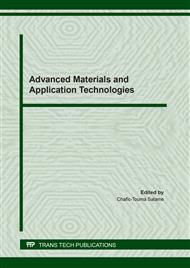[1]
M. A. Carvalho, C. Calil Júnior, H. Savastano Junior, R. Tubino, et M. T. Carvalho, « Microstructure and mechanical properties of gypsum composites reinforced with recycled cellulose pulp », Mater. Res., vol. 11, no 4, p.391‑397, déc. 2008,.
DOI: 10.1590/s1516-14392008000400002
Google Scholar
[2]
S. Manjit et C. Mridul, «Glass fibre reinforced water-resistant gypsum-based composite », Cem. Compos., vol. 14, p.23–32, (1992).
Google Scholar
[3]
F. B. Ebanda, «Etude des propriétés mécaniques et thermiques du plâtre renforcé de fibres végétales tropicales», PhD Thesis, (2012).
Google Scholar
[4]
F. Hernández-Olivares, M. R. Bollati, M. del Rio, et B. Parga-Landa, « Development of cork–gypsum composites for building applications », Constr. Build. Mater., vol. 13, no 4, p.179‑186, juin 1999,.
DOI: 10.1016/s0950-0618(99)00021-5
Google Scholar
[5]
A. CHERKI, S. MOUNIR, Y. MAALOUFA, et A. KHABBAZI, « Granular cork size dependence of thermal properties of the composite material/granular cork bound with cement mortar. », Consulté le: juin 20, 2014. [En ligne]. Disponible sur: http://jith2013.uca.ma/ JITH2013/Communications/JITH103.pdf.
DOI: 10.1016/j.conbuildmat.2014.07.108
Google Scholar
[6]
A. Khabbazi, M. Garoum, et O. Terahmina, « Experimental study of thermal and mechanical properties of new insulating material based on cork and cement mortar », AMSE J. Adv. Model. Simul., vol. 74, no 7, p.73, (2005).
Google Scholar
[7]
S. P. Silva, M. A. Sabino, E. M. Fernandes, V. M. Correlo, L. F. Boesel, et R. L. Reis, « Cork: properties, capabilities and applications », Int. Mater. Rev., vol. 50, no 6, p.345‑365, déc. 2005,.
DOI: 10.1179/174328005x41168
Google Scholar
[8]
J. Sanahuja, « Impact de la morphologie structurale sur les performances mécaniques des matériaux de construction: application au plâtre et à la pâte de ciment », These de doctorat, Paris Est, (2008).
DOI: 10.1007/bf02473554
Google Scholar
[9]
L. Gil, «Cork», in Materials for Construction and Civil Engineering, M. C. Gonçalves et F. Margarido, Éd. Cham: Springer International Publishing, 2015, p.585‑627.
Google Scholar
[10]
H. Pereira, Cork: biology, production and uses. Elsevier, (2011).
Google Scholar
[11]
M. Harche et D. Bounaga, « Etude comparative du tissue fibreux dans la feuille d'alfa" stipatenacissima L". bull », Soc Hist Nat Alger, p.113–120, (1979).
Google Scholar
[12]
M. C. Paiva, I. Ammar, A. R. Campos, R. B. Cheikh, et A. M. Cunha, « Alfa fibres: Mechanical, morphological and interfacial characterization », Compos. Sci. Technol., vol. 67, no 6, p.1132–1138, (2007).
DOI: 10.1016/j.compscitech.2006.05.019
Google Scholar
[13]
S. B. Brahim et R. B. Cheikh, « Influence of fibre orientation and volume fraction on the tensile properties of unidirectional Alfa-polyester composite », Compos. Sci. Technol., vol. 67, no 1, p.140–147, (2007).
DOI: 10.1016/j.compscitech.2005.10.006
Google Scholar
[14]
B. Bouiri et M. Amrani, «Production of dissolving grade pulp from alfa », BioResources, vol. 5, no 1, p.291–302, (2010).
Google Scholar
[15]
M. Dallel, «Evaluation du potentiel textile des fibres d'Alfa (Stipa Tenacissima L.): Caractérisation physico-chimique de la fibre au fil », PhD Thesis, (2012).
Google Scholar


